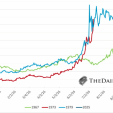Technical Stock Market Report
The good news is: In spite of a down week new lows remained at non-threatening levels.
The Negatives: The NYSE and NASDAQ markets continue to performing differently internally vis-a-vis the NASDAQ weaker than the NYSE -- and the secondaries are underperforming the blue chips.
The first chart covers the past six months showing the NASDAQ composite (OTC) in blue and a 40% trend (4 day EMA) of NASDAQ new highs divided by new highs + new lows (OTC HL Ratio), in red. Dashed vertical lines have been drawn on the 1st trading day of each month. Dashed horizontal lines have been drawn at 10% levels for the indicator, the line is solid at the 50%, neutral level.
OTC HL Ratio fell to a slightly negative 46%.

The next chart covers the past 6 months showing the OTC in blue and a 10% trend (19 day EMA) of NASDAQ new highs in green.
OTC NH has been rising sluggishly.

The next chart is similar to the one above except it covers the past year.
Here you can see how the long term deterioration of this indicator is continuing.

The next chart covers the past 6 months showing the S&P 500 (SPX) in red and NY NH, in green has been calculated from NYSE data.
This chart looks pretty impressive hitting its high point for the period a week ago.

The next chart is similar to the one above except it covers the past year.
This chart also shows the longer term deterioration of NY NH.
A long time ago I developed a trading system that imposed a no sell filter when the value of this indicator was above 130. The current value of this indicator is 76.

The positives: New lows rose a little last week, but remained at non threatening levels.
The chart below is similar to the 1st chart except it shows the SPX in red and NY HL Ratio, in blue, has been calculated from NYSE data.
NY HL Ratio declined a little, but finished the week at a very strong 82%.

April
Since 1963, over all years, the OTC in April has been up 68% of the time with an average gain of 1.6%. During the 4th year of the Presidential Cycle April has been up 54% time with an average gain of 1.1%. The best April ever for the OTC was 2001 (+15.0%), the worst 1970 (-18.5%).
The average month has 21 trading days. The chart below has been calculated by averaging the daily percentage change of the OTC for each of the 1st 11 trading days and each of the last 10. In months when there were more than 21 trading days some of the days in the middle were not counted. In months when there were less than 21 trading days some of the days in the middle of the month were counted twice. Dashed vertical lines have been drawn after the 1st trading day and at 5 trading day intervals after that. The line is solid on the 11th trading day, the dividing point.
In the chart below the blue line shows the average of the OTC in April over all years since 1963 while the black line shows the average during the 4th year of the Presidential Cycle over the same period.

Since 1928 the SPX has been up 63% of the time in April with an average gain of 1.3%. During the 4th year of the Presidential Cycle the SPX has been up 50% of the time with an average loss of -0.6%. The best April ever for the SPX was 1933 (+42.2%) the worst 1932 (-20.2%).
The chart below is similar to the one above except it shows the daily average performance over all years for the SPX in April in red and the performance during the 4th year of the Presidential Cycle in black.

Since 1979 the R2K has been up 59% of the time in April with an average gain of 1.5%. During the 4th year of the Presidential Cycle the R2K has been up 44% of the time with an average return of 0.0%. The best April ever for the R2K, 2009 (+15.3%), the worst 2000 (-6.1%)
The chart below is similar to those above except it shows the daily performance over all years of the R2K in April in magenta and the performance during the 4th year of the Presidential Cycle in black.

Since 1885 the DJIA has been up 60% of the time in April with an average gain of 1.3%. During the 4th year of the Presidential Cycle the DJIA has been up 50% of the time in April with an average loss of -0.6%. The best April for the DJIA 1933 (+40.2%), the worst 1932 (-23.4%)
The chart below is similar to those above except it shows the daily performance over all years of the DJIA in April in grey and the performance during the 4th year of the Presidential Cycle in black.

Conclusion
Some of the breadth indicators weakened last week -- and the secondaries have underperformed the blue chips for the past two weeks.
I expect the major averages to be lower on Friday April 1 than they were on Thursday March 24.
Last weeks positive forecast was a miss.
********
Disclaimer: Charts and figures presented herein are believed to be reliable but I cannot attest to their accuracy. Recent (last 10-15 yrs.) data has been supplied by CSI (csidata.com), FastTrack (fasttrack.net), Quotes Plus and the Wall Street Journal (wsj.com). Historical data is from Barron’s and ISI price books. The views expressed dare provided for information purposes only and should not be construed in any way as investment advice. Furthermore, the opinions expressed may change without notice.

















